We use cookies to ensure that we give you the best experience on our website. If you continue without changing your settings, we will assume that you are happy to receive all cookies on the Business Car website. However, if you would like to, you can change your cookies at any time

The start point for the best source of fleet information |
Final report: Volvo XC40 Recharge long-term test
Date: 31 March 2021 | Author: Guy Bird
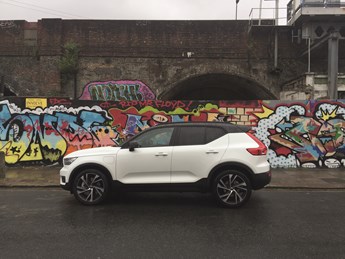
|
|
||||||||||||
Final Report: Swedish convert
After almost eight months with the Volvo XC40, it's time to revaluate what we liked and didn't, and give a verdict. First impressions were good back in July 2020. Concept cars that make production with few changes - like the 2018 XC40 did from its 2016 Volvo 40.1 beginnings, see inset photo for evidence - are rarities. The purity of the designers' original intent was retained in all its distinctive angular glory and that C-pillar in particular still looks like nothing else on the road.
Consequently, every journey in our XC40 felt like 'an event'. The XC40's interior is just as smart, with subtle touches, great fit and finish, and strong build quality. All doors shut with a reassuring 'clunk' and we can't remember anything rattling or threatening to fall off.
We spent a whole report extolling the XC40's design and another waxing lyrical about its seat comfort, practicality and quality. It's pretty practical as well, with a boot space ranging from 460 to 1,336 litres. Standard safety kit is above average - very on-brand Volvo - but a lot of other items are extra, even on our middle-to-top trim R-Design Pro, from Apple Carplay integration to a rear parking camera. The one omission we could have done with as city dwellers used to tight parking spots was front park sensors, which were only standard on the second-to-top trim Inscription (or £325 if specified separately).
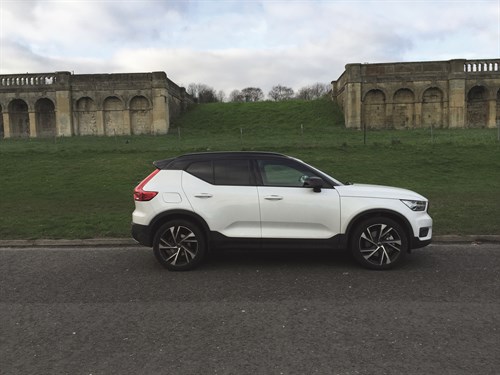
Most customers don't buy Volvos for how they drive, but the XC40 is decent enough. The 1.5-litre petrol engine offers 180hp plus another 82hp from the electric motor and had enough poke for most situations. Steering was firm-ish and brakes decent - and enhanced in re-gen B+ mode - and there was always a general air of solidity through bends and over uneven terrain. The assisted driving feature, which keeps the car in-lane along multi-lane roads, was rarely used because it tended to plot a course too close for my liking to vehicles to the car's left, especially high-sided lorries. I still prefer to steer, but adaptive cruise control was handy through 50mph road works.
The portrait-shaped 9in centre screen wasn't bad, but now feels a little dated in speed and function, and the Volvo app was all right up to a point, informing me when re-charges were complete and allowing me to lock the car remotely if I forgot. Promised updates should offer more. But the app or smart design could not disguise this plug-in's shortcomings. Volvo claims 26-28 miles of electric-only range (WLTP cycle) but when we charged - taking up to three hours each time - the driver display never indicated more than 24 miles and usually delivered 20 or fewer. Our best overall fuel figure was 45.1mpg and our worst 20.6mpg over nine petrol fills and 15 electric charges. Average consumption after 2400 miles equated to 32.4mpg, nowhere near the official 118-135mpg. More plugging would have helped, but without a home driveway that's hard work and we did try. Meanwhile, this XC40 Recharge still attracts a very useful 12% BIK band though, which will only rise to 13% this April.
Overall, we very much enjoyed the XC40, because despite its flaws - from weak touchscreen to poor real-world EV range - the way it looked and how it made us feel when driving allowed us to forgive its downsides. With improved screens and Google-backed tech set for future versions and all-electric options now available, most of our existing gripes will soon be addressed. Our verdict then? After nearly three years on the market, the XC40 is (still) one of the most desirable medium crossovers out there.
7th Report: Sitting comfortably (and stylishly)
Seats normally make automotive headlines when they're bad. Indeed, back pain caused by unsupportive ones - if my reader inbox as a fleet magazine staffer many years ago is any guide - has long been a worryingly common problem for company car drivers, especially those doing high mileage.
So it feels only proper to redress the balance by shining a light on the XC40's extremely good ones. For decades now, Volvo has had strong form in this area, both making seats safe - it famously made the three-point seatbelt standard back in 1959 - but also supremely comfortable.
As standard all XC40 seats get a height and tilt adjustable driver seat and 60/40 split-fold rear seats as (you might be surprised that some premium makers have often charged for the latter) and in higher trims extra function and comfort features abound.
In R-Design trim the front seats gain seat base extensions to support the upper thighs and cosseting dark, smooth and perforated leather upholstery graces the side bolsters to both back and base, offset by white contrast stitching and even a little blue-and-yellow Swedish flag as a nod to Volvo's country of origin. Better still, grippier and sweat-wicking matt nubuck sensibly covers the centre sections of all seats to stop those inside sliding about or getting too hot under the collar.
When you do need a temperature boost, however, on our R Design Pro spec version the front seats are heatable - a boon right now with snow still falling in the southern parts of England as I write this article.
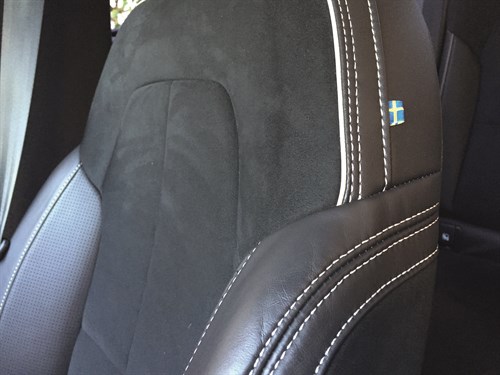
The driver's seat is electric-powered with a memory function too, something my slightly shorter-of-leg wife appreciates every time she has to do the vehicle piloting after a journey when I've had the seat pushed back and downward. Power-folding rear-seat headrests are a handy extra feature when preparing the car's loading bay for longer loads and are part of the Convenience pack optioned on our long-termer for £650, as is driver-side, under-seat storage.
It's not all about the driver - the four other passengers in this spacious five-seat cabin don't feel left out. In earlier reports we've commented on the sharply diagonal exterior rear window graphic, which helps the XC40 stand out on the road so well, but naysayers of similar cars have sometimes worried that such aesthetic design flourishes come at the expense of rear passenger vision or even well-being.
The basic idea is that if passengers can't see over such rising cabin window lines they might get nauseous on long journeys, as potentially restricted views of the landscape rob young kids of a soothing horizon line to keep car sickness at bay.
Whether you believe this theory or not, luckily my two tall teenage daughters are now more likely to have issues with scraping their heads on the ceilings of some sloping car roofs than with being able to see out, but they have reported neither restricted window views nor cramped head space while in the XC40. Shorter and younger kids in car booster seats should similarly be fine in this Volvo.
The outer rear seats are also generously sculpted in the seat base area, so the only possible place you might not want to spend long periods of time in a XC40 is the centre rear jump seat. But that's everyone's least favourite pew in any car in any case. Long and short, Volvo still has some of the most comfortable seats in the business and the XC40 is no exception. Hats off.
6th Report: Limiting screen time
Going 'portrait' in screen orientation was a key differentiator for Volvo among mainstream carmakers when it launched the second-generation XC90 large SUV back in 2015. Tesla had already gone 'big-and-vertical' with its Model S centre screen awhile earlier, but it was only an outlier brand at the time. So the 'portrait' move, by a brand with the sales size and legacy of the Swedish marque, was a marked change from the usual automotive default 'landscape' orientation, and reflected how most of us had been viewing and interacting with our smartphones for almost a decade (Apple's iPhone launched in 2007).
Volvo's XC40 compact SUV followed the same screen approach as its XC90 big brother at its UK showroom unveiled in early 2018, and it still has much to commend it. The extra depth of the 9in colour screen also allows one large image window to be viewed clearly, while keeping others minimised below for an easy 'one-click' access when a swap-in priority is required. Further features are just a swipe away. Swiping to the left accesses regular features like FM or DAB radio or applications like Spotify, while swiping to the right will locate car functions like park assist. And, as most carmakers now offer but didn't in 2018, the XC40's map can be zoomed in and out of at a pinch, just like modern portrait-oriented smartphones.
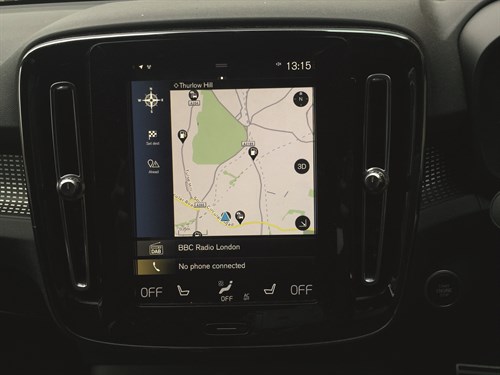
The only trouble is that this now five-year old Volvo infotainment technology is ageing way faster than the three-year old XC40 production car that houses it - an exterior design that feels as fresh as the day it was shown to the world as the mid-2016 Concept 40.1. In contrast, many of the XC40's infotainment features have proved elusive, slow or both.
Take the XC40's sat-nav system as one crucial example. Searching for a UK postcode is only possible via a non-intuitive click of a small 'Address' option at the top right of the bar within the 'Destinations' sub-menu, despite there being another more prominently displayed 'Address' option in the main part of the screen menu below, which doesn't help. We've got to grips with dozens of sat-nav systems at Business Car over the years, but only discovered this odd postcode route via PR assistance. Now we know, it's easy but it still seems an indirect way of doing things. Similarly, the in-car Spotify app much-trumpeted by Volvo routinely fails to connect to the internet - it's much easier to use the app on my linked smartphone instead - and I've still failed to find any electric charging points on the map, even when searching for them specifically by typing in key words like 'Charging' and 'Electric' via the system's magnifying glass icon. Indeed, the best that such searches have elicited so far, despite numerous attempts, are charging points that happen to have those key words in their business or network name. I suppose it's environmentally reassuring to know that Sheffield and Belgium also have available charging points (see inset picture) but I'd prefer to know about charging points located a bit nearer to me.
All of this makes the £300 option of Apple Carplay and Android Auto smartphone integration, with two USB ports thrown in, a very wise idea right now. Once plugged in and quickly linked to the car, Apple's MirrorLink system provides real-time mapping, decent Siri voice control to easily reply to text messages and access to music - either via my Spotify account or through the music stored on my smartphone. The good news is that a new Google Android operating system, which promises to be much quicker and more intuitive features on the full-electric XC40, is due this spring, and will replace Volvo's in-house Sensus system on the rest of their range as facelifts and all-new models launch too.
5th Report: Volvo's eye for design evident in compact SUV
The ace up Volvo's sleeve is a design team on a superb run of form, culminating in the excellent XC40. The Swedish brand's combination of stand-out exterior design - nothing looks quite like its latest compact SUV despite having 20-odd rivals - plus subtle interior design, which in our test car's example features muted greys and black punctuated by discreet but distinct shiny areas and details, makes me feel good every time I drive it.
Key to the XC40's exterior are chunky proportions with a high and clamshell-style bonnet and a thick and diagonal C-pillar. The chrome edging so prevalent in the past decades of car design has been dispensed with, and this minimal approach, although far from simple to achieve, is backed up with just the right amount of bodywork attention. Note how the lower door area is so deeply carved out with a precise diagonal graphic edge, mirroring the diagonal-leaning C-pillar above, which helps make the car appear visually tauter and cinched, rather than flabby or slab-sided. Other cars take this approach as well, but few execute it as well. All of which make the car distinct, and if Volvo's still rising global sales are any guide, highly desirable too. Which in turn has the business benefit of better onward residual values and happier and more content drivers.
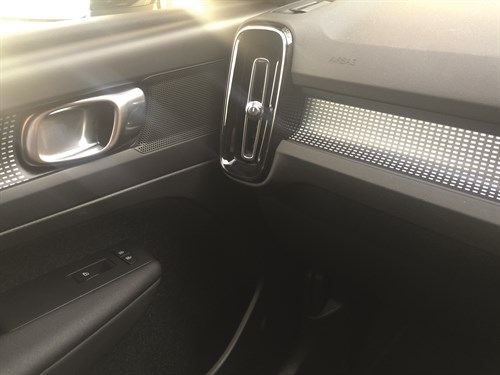
Inside, this sculpted approach is echoed in the horizontal concave section of the passenger side dashboard and also in the door panels behind the shapely door-pull. Alongside the perforated metal speaker section and the vertical lozenge-shaped air vent (see image, above) the combined effect is a great example of well thought-out and integrated design. Beyond the aesthetics there are plentiful cubby holes - many of which have rubber mat floors to stop keys, phones and more sliding about - and comfortable seats neatly trimmed with hardwearing leather bolsters.
The overall effect is special, but drill down into the XC40's specification and it's worth noting that the customer has to pay for a lot of its functions. Even on our middle-to-top trim R-Design Pro, £3,825 of extras are added, including Apple CarPlay and Android Auto smartphone integration, and two USB ports (£300), button-activated power-operated rear hatch and puddle lights (as part of the convenience pack, £600), and adaptive cruise control, blind spot assist, and auto-brake rear collision mitigation (as part of the Intellisafe Pro safety pack, £1,500). Even the premium metallic white paint is a hefty £850 (Volvo's regular metallic paint is a more palatable £575).
Of course, you can cut your cloth as befits your budget, but one item I'm surprised is only standard, on the second to top trim Inscription, is front park assist. It's £325 if specified separately. As mentioned at the beginning of the report, the front bonnet of the XC40 is high, and it's sometimes hard to see where it finishes from the driver's seat, so a standard front sensor to go with the standard rear parking sensor (if not associated camera) would be a positive addition.
4th Report: Charging reality dawns, but a boot that fits...
Since my second report I've really been trying to make my XC40 Recharge live up to its name by plugging in as much as possible to allow more miles to be driven in EV mode. That's the major justification of any plug-in hybrid and the reason why they're granted such generous tax breaks (this XC40 has a 12% BIK rating). What's the point of lugging round those extra batteries and electric motor if not to ensure as many missions without emissions as possible? (For context, the T5 Recharge weighs 1,741kg, while an otherwise equivalent 1.5-litre petrol T3 FWD auto is nearly 200kg lighter at 1,554kg.)
I've been making copious refuelling notes too. Since my last petrol fill-up with 1,859 miles on the clock I've travelled 375 miles before my latest fuel station visit. In between I've recharged the XC40's battery no fewer than seven times - five with the kind permission of a nearby neighbour via their private driveway and wall box and twice at a public lamp post charger around the corner from my house. Despite the Volvo brochure citing an electric range of between 26.1 and 28 miles when full, the figure on my XC40's driver display has never shown more than 24. In use, my EV range reality has rarely been more than 20 miles and sometimes less. Away from this special experiment, seven separate fill-ups - crucially, not at my house and taking three hours each - to gain circa 140 miles is certainly not something any normal person is likely to do.
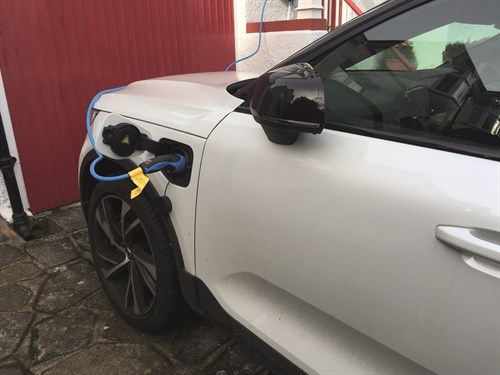
The resulting 48.5mpg figure gained for this month isn't bad and is a big jump on the 30-something mpg I was getting with little or no little electric fill-up help, but it shows how hard it is to achieve the 118-135mpg official figures. Figures, it should be noted, that are based on the newer WLTP test, which entails driving the car fully electric for 14.4 miles at various speeds, then again the same distance on petrol power alone and dividing the two mileages by the petrol fuel used. That means to get anywhere near official PHEV mpg figures you need to drive your plug-in for as many miles in EV mode as non-EV mode - which, if you don't have off-street parking and a wall box where you can easily top up your PHEV without fuss, is a time-consuming undertaking.
Luckily, the XC40 Recharge's abilities extend well beyond its plug-in capability. It's a capacious load-lugger, with 586 litres available in regular boot mode behind the five seats up and loaded to the roof. Fold the rear seats down and you can squeeze in 1,336 litres.
It's also good at swallowing awkward-shaped cargo. Case in point: just before the latest national lockdown I went to borrow a marquee from my sister to create an extra covered room in my garden. As the longest of the marquee's poles are 1.9m and there are four boxes of them, it was touch and go whether I'd need a small van. But after careful measuring with the front passenger seat slid and bent forward as far as I thought it would go, I took the plunge and made the 30-mile trip. Three of the four boxes made it in diagonally with both rear seats folded with no problem, but the fourth made the 1.9m pile higher than the inward sloping rear hatch would allow. One last trick up my sleeve saved the day: ratcheting up the front passenger seat height shifted it slightly forward as well as upward and allowed the last 1.9m pole box to slot in and the boot to shut. In the words of the 5pm sports results reporter: "Bird Family United, one; Lockdown Restrictions, nil."
3rd Report: Appy go lucky
Smartphone apps for electric or part-electric vehicles have been around for years but I've tended to view most of them as only really helping mainstream carmakers project a veneer of technological advancement rather than much real, everyday functionality. I remember having one with a previous test EV - an early-days BMW i3 - that told me when the car was fully charged and how many miles it had gained, but seemingly not much else of practical value. It was useful up to a point. Similarly, apps from various VW Group brands that appeared on their cars' centre screens when using mirror-link systems like Apple Carplay only revealed "coming soon"-type nothings when clicked into.
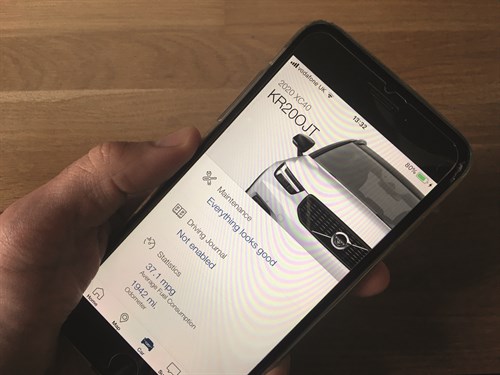
Despite this, as part of my XC40 user experience I thought I should see if things have moved on and downloaded the Volvo OnCall app anyway. I have to say it has already proved quite useful for reasons other than the typical range information I've been used to. For example, on one occasion while the XC40 was a few hundred yards away charging on a neighbour's drive via their new wall box - my current charging solution due to the lack of accessible public ones near me - I checked the app to see when the charge would be finished. On the same page of the app as the charging info I noticed it was also displaying the car's security status as 'unlocked' rather than 'locked' and allowed me to lock the car remotely with one press of my finger on the smart phone. On another occasion the app let me know that I'd left one of the car's windows open. Given it was due to rain overnight and I don't have a garage, that was also a helpful prompt that would otherwise no doubt have resulted in a very wet cabin in the morning.
A third feature of the OnCall app that Volvo has been keen to promote is one that shows PHEV owners how far they have driven in electric-only mode to encourage them to use the car's zero-tailpipe emission propulsion as much as possible. Due to a temporary software glitch this function isn't currently working but the good news is that Volvo says its app is being further developed and updated and with additional services slated too. These include allowing drivers to see the impact of their driving on their overall CO2 footprint as well as estimates of fuel costs saved by driving in full-electric mode.
Before all of that extra app functionality comes on stream I've been doing some of those calculations on my own. Based on charging via local street lamp post points like Ubitricity at 24p per kWh, 10.266kWh over three hours gains 24 electric miles and costs me about £2.50. That's half the £5 it costs to fill up with a gallon of petrol and achieve circa 30mpg (driving without any electric-only miles). Juicing up via my neighbour's Chargemaster wall box is cheaper still at 14p per kWh or roughly £1.40 per 24 electric miles. So for reasons of ease and cost-saving I'll be hoping to charge on my neighbour's driveway for as much of the time as possible and will definitely add him to my Christmas card (and gift) list.
2nd Report: Emotionally charged start
Obtaining an electric charge without off-street parking was always going to be one of the big challenges of this six-month test, but as I said in my previous report a valid one, given how electric and part-electric motoring is being pushed to city dwellers as a way of reducing local air pollution. The process should be more straightforward than in previous years because two on-street chargers have been installed close to my London house, one with a proper designated bay and the other within a street lamp post.
The latter option is much nearer and avoids major main roads, and although it does not have its own electric vehicle bay markings outlined on the street, I'm already organising parking place swaps when I need to recharge as I happen to know most of my neighbours and the cars they drive. Longer-term, as these lamp post chargers proliferate - because they are cheaper and easier to install and require less planning and street disruption - seizing such spots should hopefully become easier. Right now, they're anything but.
Maybe it's partly because of lockdown-related restrictions - many more roads are temporarily being narrowed or closed to through traffic - or indeed less work meaning fewer reasons to drive, but people seem to be driving less in the capital, and when they need to, they're finding it harder to do so. On my empirical evidence only there seem to be a lot of semi-abandoned cars in my area left by people from elsewhere. Not permanently - they're not old bangers. I've checked a few number plates online and they're taxed - for now. Consequently, my nearest charging space has been occupied by a non-moving Ford Focus for at least a month. The few times I've managed to swap with a neighbour to the car space nearest to that bay, I have just about got the cable to stretch diagonally across to the front passenger side of the XC40 where the car's socket resides (see picture, below). But that's a lot of trouble for circa 25 miles of electric range compared to hundreds of petrol miles in minutes from a regular fuel station.
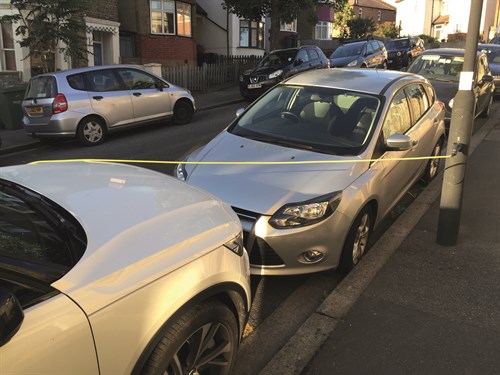
Further afield, the lamp post charging story is similar. Non-EV or PHEV cars are almost always parked in the EV charging spaces. To be fair to those drivers, there's often no signage on the lamp post to indicate it's available for EV charging or only a tiny sign if there is. And with no bay markings on the floor and in a city where free on-street parking is at a premium, who can blame them? It's just frustrating and gives the lie to the seemingly bountiful inner-city free charging options, indicated as available by the likes of Zap-Map, but in reality inaccessible. On other occasions further afield, half a dozen notional charging stations were listed just where I wanted to be, but ended up variously within an expensive car park, inaccessible due to a closed road, or on a part of the street restricted to buses, taxis and cycles. After 30 minutes going round in circles, I ended up finding none I could actually plug into. So I parked on a single yellow line, as it was a bank holiday (and carried on using petrol).
On longer drives - and I've done plenty of them too - leaving the gear selector in B+ rather then D to boost regenerative braking, up to 10 electric 'bonus miles' can be gained over 100 miles or so of driving. That's good and has allowed me to adopt a 'one-pedal' EV approach for much of the time, coasting up to traffic lights and junctions and barely having to dab the actual brake pedal. It still feels great to silently start journeys in electric mode, but I'd like to make more of my miles electric ones. I'm going to redouble my efforts.
Volvo XC40 Recharge T5 R-Design Pro
P11D price: £42,250
As tested: £46,130
Official consumption: 118-135mpg
Our average consumption: 45.1mpg
Mileage: 1,542
1st Report: Plugging (into) Swedish culture
In the world of compact SUVs almost every mainstream and premium brand is now represented. But among the two dozen-plus models available the Volvo XC40 is still one of the standout designs on account of its chunky and angular creases, most recognisable at a glance in the diagonal section of the rear door window line. At 4,425mm long, 1,910mm wide and 1,658mm high, the XC40 is longer than the Jaguar E-Pace (4,411mm) and shorter than the BMW X1 (4,447mm).
There's Swedish design rationalism evident in the solid and safe-looking exterior shapes, plus restrained sophistication in the simple minimal-button interior accented by the concave-shaped and metallic rectangular-pattern filets running through the dashboard and interior door panels. The car does have shiny bits but they aren't too big or numerous. They don't shout 'look at me' but they're noticeable. Passenger space front and back feels decent and materials are quietly upmarket, while the boot space ranges from an OK 460 litres with the seats up to a large 1,336 litres seats down, when luggage is packed up to the ceiling.
Offering a plug-in hybrid variant reduces the competition further. The front-wheel drive XC40's T5 Recharge only employs a three-cylinder 1.5-litre petrol engine but offers 180hp plus another 82hp from the electric motor, which is plenty enough for smooth sailing. When swifter getaways are required it can also record 0-62mph in 7.3 seconds. That calm feeling of progress starts from start-up. There's no diesel rattle or petrol thrum - just a slight electric 'wheee' sound once the automatic gearbox selector is put into Drive. Volvo claims 26-28 miles of electric-only range (based on the WLTP cycle) but from the few plug-ins we've done so far no more than 24 miles have been obtained in any one session, which usually takes about 2.5 to three hours.
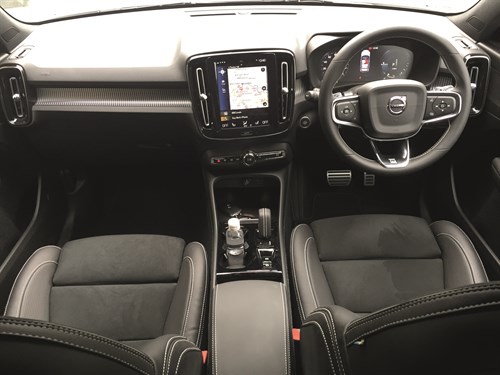
Obtaining those electric miles without off-street parking is going to be one of the challenges of this six-month test, but a valid one given how electric and part-electric motoring is being promoted to city dwellers as a way of reducing local air pollution. The process should at least be more straightforward than in previous years. Case in point: within the past 12 months two on-street chargers have been installed within a few hundred yards of my house, which is in London - one with a proper designated bay (and rapid-charge options for full EVs) and the other a quick-fix lamp post plug type. On longer drives - and by leaving the car in B rather then simply D, regenerative braking is greater and can gain up to 10 electric 'bonus miles' over 100 miles of driving.
Tax is a significant factor in any PHEV purchase and the XC40 Recharge records an official combined consumption of 118-135mpg and a 47-55g/km CO2 rating, equating to a usefully low 12% BIK band. How many times we manage to recharge will determine how close we get to that mpg range figure of course, but the BIK band is in the bag for this year and only rises to 13% next tax year and 14% in 2022/23.
Standard safety kit is well above average, as you'd hope for a brand so associated with avoiding or mitigating crashes, but a lot of other items are extra, even on our middle-to-top trim R-Design Pro, from Apple Carplay integration to a rear parking camera. Our test vehicle has a significant £3,825 of extras added - including more great safety features and some convenience ones too, like an electric-closing rear hatch - but still no front parking sensors. All in all though, the XC40 PHEV feels like a lot of car to talk about. We'll be looking forward to doing just that over the next half-year.
Standard equipment: Seven airbags, traction and stability control, city safety inc. pedestrian, cyclist & large animal detection and front collision warning with automatic emergency braking, oncoming lane mitigation, run-off road protection, LED headlights with active high beam, Volvo On Call with app, climate control with clean-zone air quality system, cruise control, hill-start assist, electric parking brake, tyre deflation warning system, rear parking sensors, LED headlights, 12.3in TFT colour driver display, 9in central touchscreen with satnav, DAB radio, voice-activated control, Bluetooth and DAB, 20in alloys.
Options: Premium Metallic Paint (£850); Intellisafe Pro pack (£1500) inc. auto-dimming exterior rear-view mirrors, Intellisafe Assist (pilot assist and adaptive cruise control), Intellisafe Surround (blind-spot info system with steer assist, cross-traffic alert with autobrake & rear collision mitigation); Convenience pack (£600) inc. power-operated tailgate, power-fold rear headrests, driver side under-seat storage, keyless drive with remote tag plus hands-free tailgate opening/closing & puddle lights; Tempa spare wheel and jack (£150); rear park assist camera (£375); smartphone integration (inc. Apple Carplay and Android Auto) with x2 USB Hub (£300); 4.5m Type 2/Mode 3 charge cable (£50).











